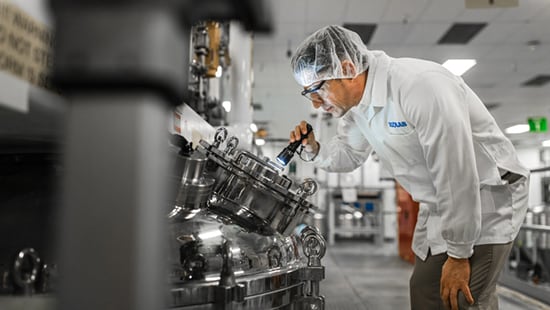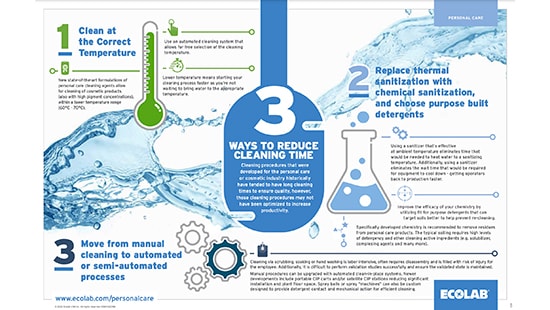Learning to Leave Old Cleaning Trends Behind for New Opportunities
Usually, initiatives to drive innovation in regulated markets do not consider innovations in cleaning and sanitizing. In reality, cleaning and sanitizing are often not an area of focus for improvement, leaving antiquated methods tying up resources unnecessarily.

There are three areas where technology has progressed that can significantly impact cleaning and sanitizing resources:
- Targeted cleaning chemistry
- Automated cleaning technologies
- Improved sanitization techniques
Targeted Cleaning Chemistry
The first area that has improved is in cleaning chemistries. Before the days of built detergents, commodity ingredients were commonly used as cleaners. For consumer products that were water soluble, water itself was often used to clean. If this did not work, sodium hydroxide, citric acid, or salt might break down emulsion or fat to improve cleaning. For tough waterproof soils, solvents were often used, and in many cases are still used today.
These older methods present several challenges. Water washing can result in inadequate soil removal that may not reveal itself excessive residues or biofilm result in a quality issue. Similarly, commodity chemicals may dissolve some components of a product soil but leave sediment or residue from those components that are not dissolved. Finally, solvents present a safety hazard for employees and air emissions headaches for the facility.
Fortunately, built detergents are designed to tackle these types of cleaning issues efficiently and safely. Ingredients are combined to solubilize, suspend, and remove soils seen in the personal care and dietary supplement industries. For soils that require extended time to dissolve or release, additives such as foaming agents or gelling agents can suspend the cleaning solution on the soil for added contact time. The key is finding the right built detergent with the right components to address the target soils most efficiently.
Automated Cleaning Technologies
The next area where technology has progressed is in cleaning automation. Historically, equipment was cleaned manually, either in-place or out-of-place. In-place cleaning may have been through a fill / soak method, or tank entry / scrubbing. Out-of-place often means equipment disassembly and hand washing in a 3-compartment sink. In either case, the cleaning is labour intensive, and filled with risk of injury for the employee. In addition, personal care and dietary supplement manufacturers are required to demonstrate effective and reproducible cleaning and sanitization processes, i.e. validation. It is difficult to perform validation studies successfully and ensure the validated state is maintained with manual cleaning operations.
Fortunately, developments in automated cleaning technologies make the process easier. Manual cleaning for equipment left in place can be upgraded with automated clean-in-place systems. The traditional centralized Clean-in-place (CIP) installation can require significant installation, consume precious plant space, and use significant amounts of water. Newer developments include portable CIP carts and/or satellite CIP stations on the plant floor. Spray balls or spray “machines” can be custom designed to provide the detergent contact and mechanical action for efficient cleaning. And water can be reduced by using burst wash/rinse techniques, and by strategically capturing rinse water for use in subsequent pre-rinse steps.
For equipment that is disassembled for cleaning, clean-out-of-place (COP) technologies have been developed to make that process less labour intensive as well. New technologies include automated COP soak tanks, parts washing tunnels, and enclosed parts washing cabinets. In any of these cases, detergent and sanitizer can be dosed into the equipment to reduce employee exposure. Mechanical action is provided by designed fluid flow (soak tank) or strategically placed spray nozzles (tunnel and cabinet). In some cases, spray nozzles can be positioned on a cart to point directly into a difficult-to-clean crevice or pipe. Regardless of the technology, these automated COP cleaning technologies provide a reliable cleaning process that can be validated with confidence, while improving employee safety and perhaps even freeing employees for other tasks.
Improved Sanitization Techniques
While chemical sanitization has been a mainstay in food manufacture to control spoilage organisms, the traditional sanitization method in personal care and dietary supplement manufacturing has been either hot water or steam sanitization. This method requires heating water either remotely or at point-of-use to at or near boiling, then exposing all equipment surfaces for an extended period of time, often 30 minutes or more. This is a time-consuming and energy-intensive process to heat the system, hold for residence time, and then cool for the next operation. Additionally, some equipment experiences fatigue from the repeated heating cycles.
Newer sanitation applications have been developed using chemical sanitization. Regulatory bodies like EPA in the United States and European Commission in Europe have responded to pressures for chemical sanitization for non-food product contact surfaces by approving modified test methods appropriate for those industries. As a result, registered sanitizers with claims targeted for sanitization, disinfection, and even biofilm removal are available. These new sanitizers can be diluted with city water or purified water and applied at ambient temperature for significantly less time than heated sanitization. The result is an effective disinfection utilizing less water, less energy and, less time than prior.
Summary
Innovations in cleaning chemistries, cleaning methods, and sanitization techniques can offer improved efficacy, reduced resources (labour, water, energy), and a safer environment for your employees. These technologies have been commercialized for quite some time and used by best-in-class manufacturers. While cleaning is not the most glamorous operation for most manufacturers, focus on improving those operations can provide benefits Operations Leaders aggressively seek.

Want to Learn More?
Download our latest eBook: Driving Plant Performance through Modernized Cleaning: How Outdated Cleaning is Holding Production Operations Back and How to Fix It
- Why Cleaning Challenges are Tougher than Ever
- How Outdated and Sub-Optimal Cleaning Protocols Impact Performance KPIs
- Tips to Evaluate the Business Impact (Good or Bad) of Your Cleaning Programme
- How to Build a Modernized, Performance-Enhancing Cleaning Programme

Insight Into Increasing Production
Download the 3 Ways to Reduce Cleaning Time infographic for some insights into increasing production.



